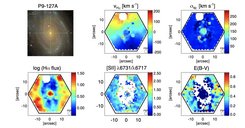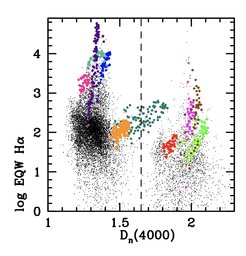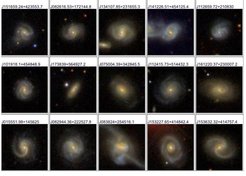Nearby galaxy centres with unusual populations of very massive stars
A new study of galaxies with data from the MaNGA survey shows that the initial mass function of stars, i.e. the mass distribution when they initially form, might not be as universal as widely assumed. The MPA study found an excess of very massive stars in some galaxies. An excess of radio sources in the sample might be an intriguing hint that a hidden population of black holes may exist in these galaxies.
How the first black holes in the Universe form is one of the key unanswered question in astrophysics. The main triggering processes that drive subsequent episodes of black hole growth also remain a mystery. Models for seed black hole formation generally fall into two categories: 1) direct collapse of low angular momentum gas clouds, 2) mergers and accretion in dense stellar clusters.

MPA's scientists have been using data from the Sloan Digital Sky Survey to gain insights into the processes that drive black hole growth for almost 20 years. The latest data from the “Mapping Nearby Galaxies at APO” (MaNGA) survey promises to open up a new domain in such studies. Unlike previous surveys carried out by the Sloan Digital Sky Survey consortium, which obtained spectra only at the centers of target galaxies, MaNGA obtained spectral measurements across the face of each of ~10,000 nearby galaxies.
The MaNGA program used 17 simultaneous "integral field units" (IFUs), each composed of tightly-packed arrays of optical fibers. From this data a multitude of galaxy parameters can be derived: two-dimensional maps of stellar velocity and velocity dispersion, mean stellar age and star formation history, stellar metallicity, information about the abundance of different chemical abundances, stellar mass surface density, ionized gas velocity, ionized gas metallicity, star formation rate and dust extinction.

The models used to derive many of these quantities usually assume that the initial mass function (IMF) of stars is the same everywhere, i.e. there is a uniform mass distribution of stars when they initially form. But is this really true? The most generally accepted evidence that the IMF may deviate from the standard form for the most massive stars comes from studies of star clusters near our own Galactic Center. These reveal an excess of massive and young Wolf-Rayet and O- and B-type stars that are partitioned between two rotating disk-like structures. Because of the young ages (6-8 Myr) of these stars, they are believed to have formed within very dense, accreted gas. Massive stars end their lives as black holes rather than neutron stars, so their existence at the Galactic Center is of particular interest for black hole formation processes in extreme environments.
In a recent study carried out during long months at home during the COVID-19 pandemic, Guinevere Kauffmann used early release MaNGA data to carry out a systematic search for galaxy centers with clear indications of unusual stellar populations. In particular, she looked for systems, where the initial mass function was flatter than the standard assumption at high stellar masses.

In a sample of 668 face-on galaxies with masses within a factor of 10 of that of the Milky Way, 15 galaxies were identified with clear young massive star excesses. To reach this conclusion, Kauffmann used a variety of observable indicators such as a very high luminosity Hα emission arising from gas excited by ultraviolet radiation from young stars, as well as features characteristic of outflowing, helium-enriched material from Wolf-Rayet stars. The strength of such features increased systematically towards the centers of the galaxies, reaching levels incompatible with a standard IMF.
The study also concluded that if black hole formation was ongoing in these galaxies, it would be difficult to detect unambiguously at optical wavelengths. The ratios of the strongest emission lines in 14 out of the 15 galaxies did not provide any evidence for ionization from "hard-spectrum" sources – as might be expected if significant, unobscured black hole accretion was occurring. Only one object showed clear evidence for such accretion, along with accompanying signatures of large-scale perturbations of the ionized gas in the galaxy. However, the study also revealed an excess of radio sources in the sample compared to control samples of similar galaxies with a normal young stellar population. This is an intriguing hint that a hidden population of black holes may exist in these objects. Unlike UV and optical emission, the radio emission from relativistic particles in the vicinity of black holes would not be heavily absorbed by dust.
Efforts to probe more deeply into the mysterious range of phenomena seen in these unusual galactic centres are currently ongoing and a variety of different strategies are being employed. Stay tuned for more results...














